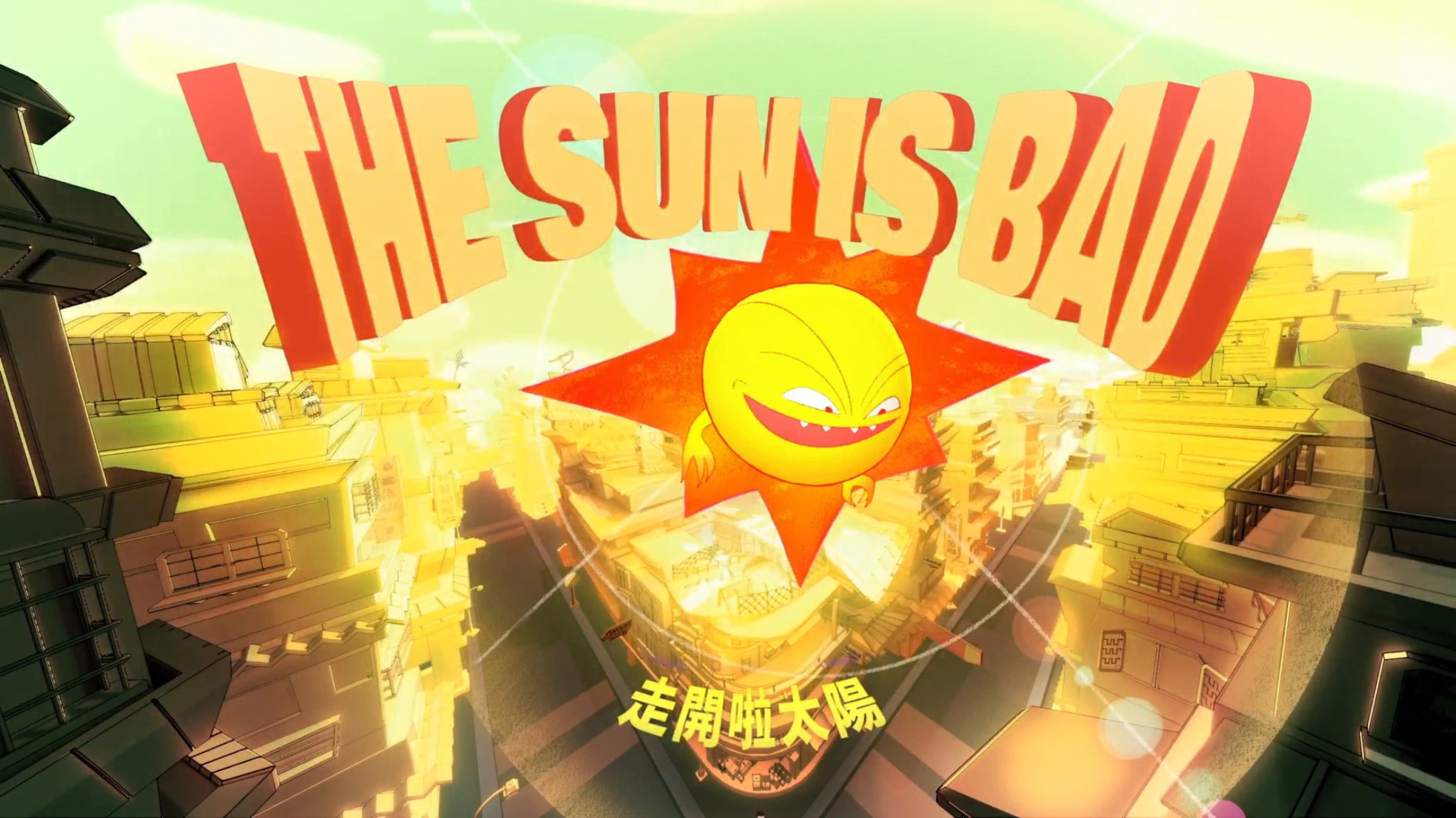Image Credit: 2D Animator – Quinn Marsh; 3D Environment – Elle Yeung, Henry Ni; Compositing – Chenrui Lan
SIGGRAPH 2024 Electronic Theater proudly presented “The Sun Is Bad”, a radiant three-minute animation that takes viewers to the sweltering streets of 1980s Hong Kong. This action-comedy follows a daring young girl on a mission to destroy the sun, blending bold creativity, cultural nostalgia, and an environmental message. SIGGRAPH had the privilege of speaking with contributor Rachel Mow, uncovering the inspiration behind this imaginative tale of resilience, humor, and heart.
SIGGRAPH: Share an overview of “The Sun Is Bad.” What inspired the central idea of a girl attempting to destroy the sun, and how does this reflect the themes of the film?
Rachel Mow (RM): “The Sun Is Bad” is a three-minute action-comedy that follows a determined young girl on a mission to destroy the sun, which she blames for melting her city. Set in Hong Kong during the late 1980s, the film not only captures the intense struggle against the oppressive heat but also evokes the nostalgic aesthetic of a bygone era.
The central idea was inspired by my own childhood experiences in Hong Kong, where the summers were sweltering and nearly unbearable. The humidity and heat were so overwhelming that stepping outside felt like melting. As a kid, I remember hating the sun and coming up with silly, imaginative ways to fight it — whether it was trying to trap it with a fishing net or “shooting” it with a toy gun. These playful ideas stuck with me, and I thought it would be exciting to tell the story from a child’s perspective, turning a simple, relatable frustration into an action-packed adventure.
At its core, the film reflects themes of resilience, creativity, and the way children perceive the world — sometimes magnifying everyday challenges into epic battles. It also subtly comments on the environmental challenges we face today, especially the intensifying heat caused by climate change. Through the lens of a child’s imagination, the film highlights how we often feel powerless in the face of overwhelming forces, but we still find ways to fight back in our own, sometimes playful, ways.
SIGGRAPH: Why was late ‘80s Hong Kong chosen as the setting, and how does it influence the narrative and mood of the film? How did you approach the visual representation of late ‘80s Hong Kong, and what role does it play in immersing the audience?
RM: Although I wasn’t born in the late ‘80s, I’ve always felt a deep connection to the older Hong Kong of that era. There was a unique sense of community, and the culture felt rich and vibrant in ways that I truly appreciate. Sadly, many of these elements are fading away, so for me, this film became a way to celebrate and preserve the Hong Kong that shaped my memories. It was important to me to transport the audience back in time and give them a glimpse of what that world was like.
To do this, we infused the film with nostalgic elements of Hong Kong culture, such as iconic neon signs, family-run grocery stores, an umbrella shop, and even the now-sunken Jumbo Floating Restaurant. These landmarks, once a part of daily life, serve as a tribute to the city’s past and evoke a sense of longing for a time that feels increasingly distant.
The visual representation of late ‘80s Hong Kong was central to immersing the audience in the narrative and mood of the film. We drew inspiration from iconic Hong Kong films and animations of the ‘80s and ‘90s, particularly the work of Wong Kar Wai. His distinctive use of color grading — washed-out, sun-drenched tones during the day and moody, neon-lit scenes at night — was a major influence on how we approached the film’s aesthetic. We also drew from the action-packed scenes in the classic comic strip Old Master Q and the beloved cartoon McDull.
In terms of mood, this nostalgic setting allows us to create a sense of warmth and familiarity for the audience, while also highlighting the tension between the past and present. The late ‘80s Hong Kong serves not only as a backdrop but as a character in itself — one that shapes the protagonist’s world and journey.
SIGGRAPH: Why did you choose the computer animation medium to tell this story?
RM: We chose computer animation for “The Sun Is Bad” because it offers unparalleled flexibility in blending stylized visuals, surreal elements, and emotional depth with precision. The medium allowed us to craft a world that feels like it’s seen through a child’s eyes, where everything is slightly exaggerated. To capture this perspective, we designed the props to be toy-like and chunky, making the world feel playful and imaginative, yet with an underlying sense of tension.
Animation also gave us the freedom to experiment with color in a way that directly supports the story’s themes. We used cool tones for the girl to reflect her character’s emotional state, and warm, fiery colors for the sun to represent its oppressive power. This color contrast not only enhances the visual appeal but also strengthens the emotional undercurrent of the film.
One particular scene — the “Sun’s point of view” — was heavily influenced by thermal camera imagery and risograph textures. Through animation, we were able to push the boundaries of reality, creating a distorted, intense visual representation of the sun’s power.
Ultimately, computer animation gave us the tools to create a surreal, exaggerated world that fits the tone of the film. It allowed for more fluid character movement, especially in how the sun and the girl interact, and gave us the freedom to design environments and effects that feel both dreamlike and unsettling, perfectly capturing the fantastical nature of the story.
SIGGRAPH: Are the toys and objects the protagonist uses symbolic, and how do they contribute to the storytelling and visual impact?
RM: The toys and objects the protagonist uses throughout the film are indeed symbolic, each one representing different aspects of her resourcefulness, creativity, and resilience. The fan, strings (cat’s cradle), and can of soda becomes more effective as the story progresses, symbolizing her growing determination and the power of imagination in overcoming overwhelming forces.
The cat’s cradle, a popular game in Hong Kong during the ‘80s, plays a particularly significant role. It’s a nostalgic nod to simpler times and childhood innocence, but it also serves as a representation of how children often turn ordinary objects into weapons of empowerment in their minds. Similarly, the fan and can of soda are everyday items that, through the protagonist’s ingenuity, become instruments of her fight, showing how she uses whatever she can find to take on the seemingly impossible task of defeating the sun.
All of these props are deliberately tied to the 1980s, both in their design and their availability. These types of items were commonly found in small, family-run convenience stores — places that were once the backbone of Hong Kong’s neighborhoods. By referencing these stores and their simple, accessible items, we further anchor the film in a time and place that feels nostalgic, yet deeply personal.
These props contribute to the visual impact by adding a layer of whimsy and playfulness to the film, while also reinforcing the themes of childhood imagination and resilience. They serve as a reminder that even the smallest, most ordinary things can have extraordinary power when used with creativity and determination.
SIGGRAPH: How does the protagonist’s determination to stop the sun symbolize a broader cultural, environmental, and generational commentary?
RM: The climax of the film, where the girl is melting and feels hopeless in her fight against the sun, is a pivotal moment. At this point, she receives powers from the Buddhas and transforms into her battle form. This scene was directly inspired by the Ten Thousand Buddhas Temple in Hong Kong, a place filled with countless shrines, pavilions, and Buddhist art, particularly the statues. Each Buddha is unique, with its own distinct face and personality, which felt like a powerful way to represent the girl’s inner strength awakening in her darkest moment.
I also wanted to immerse the audience in a nostalgic reflection of Hong Kong’s culture. By incorporating iconic elements such as neon signs, a family-run grocery and umbrella store, and even the now-sunken Jumbo Floating Restaurant, I hoped to transport viewers back in time. It’s heartbreaking to see many of these businesses and cultural landmarks fading away, so I wanted to preserve them in my own way, through the lens of this story.
As for the girl’s motivation to fight the sun, she does so because it’s literally melting her city. While this may sound like a fantastical exaggeration, it reflects the very real effects of climate change, especially in regions like India and Thailand, where extreme heat is melting their roads down.
SIGGRAPH: What guidance would you offer aspiring creators looking to submit their work to the Computer Animation Festival for a future SIGGRAPH conference?
RM: My biggest piece of advice to aspiring creators looking to submit their work to the Computer Animation Festival at SIGGRAPH is: Don’t hold back. Everyone has a unique story to tell, and the best stories often come from your own personal experiences. Don’t be afraid to explore your own voice and vision — whether it’s through a personal narrative, a cultural perspective, or a creative approach to animation. The more authentic and distinctive your work is, the more likely it will stand out.
SIGGRAPH is a fantastic platform for emerging talent. Not only is it a place to showcase your work to a global audience, but it also offers incredible opportunities to connect with industry professionals, exchange ideas, and gain valuable feedback. You’ll be surrounded by people who share your passion for animation and technology, and it’s a great chance to expand your network. Don’t be afraid to put your work out there — it’s the first step toward making meaningful connections and advancing in the industry.
Ignite creativity and inspire the future of animation by submitting to the prestigious SIGGRAPH 2025 Computer Animation Festival — an Academy Award® Qualifying Festival — before the 18 March deadline, and showcase your groundbreaking work to a global audience.

Rachel Mow is a Student Academy Award and College Emmy nominated director specializing in storyboarding and compositing. She was born and raised in Hong Kong and has a deep appreciation for the art of storytelling and a passion for the captivating world of animation. She is pursuing a career in animation to share stories and aims to use her unique perspective to entertain, inspire, and evoke emotions in viewers around the globe.



